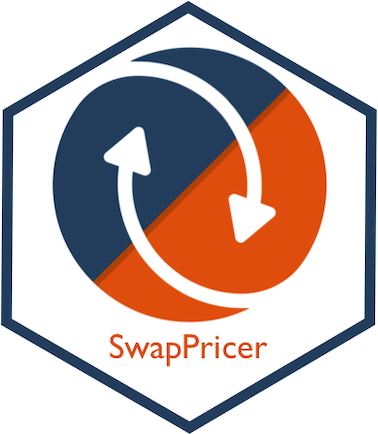SwapPricer is on Github
In the previous posts we have seen how easy it is to price interest rate swaps using R. I am honoured to announce that I have decided to put all the functions I have described together into a package that is called…SwapPricer!
Ok, the name is not super original, but it should at least be easy to remember.
You can install it as follows:
# library(devtools)
devtools::install_github("DavideMagno/SwapPricer")The package is still unfortunately not on CRAN but it has an official hexagon. Here it is:

Let me know if you like it in the Disqus form below in the post.
In order to price a swap you just need to run the following code.
library(SwapPricer)
portfolio <- SwapPricer::swap.basket %>%
dplyr::filter(grepl("EUR", .$currency))
SwapPortfolioPricing(portfolio, lubridate::ymd(20190414), SwapPricer::EUR.curves)## # A tibble: 4 x 8
## swap.id currency clean.mv dirty.mv accrual.pay accrual.receive par
## <chr> <chr> <dbl> <dbl> <dbl> <dbl> <dbl>
## 1 Swap 2… EUR -8.82e5 -8.75e5 5441. 1379. 7.71e-3
## 2 Swap n… EUR -2.59e6 -2.86e6 -263836. -5968. 1.07e-2
## 3 Swap 1… EUR -1.63e4 -2.99e4 -3808. -9749. 6.82e-4
## 4 Swap 2… EUR -3.61e5 -3.61e5 0 0 1.18e-2
## # … with 1 more variable: pv01 <dbl>You can see that I have used two objects that are delivered with the package:
swap.basket which consists in a 5 swaps portfolio that can be referenced as blueprint for your swap portfolio
EUR.curves this is the discount curve downloaded from Bloomberg as at the 14th of April 2019
We have tested the package using a 500 swaps portfolio and the results, in terms of performance are very encouraging. We analyse them using the amazing profvis tool.
The results are quite interesting as they show we can split the code in three parts:
The first one converts the inputs in tabular form into list of lists of the same format as we described in this post.
The second one is the one that takes the biggest amount of time and it corresponds to the
CashFlowPricingfunction. We have described this function in detail in this post. If we dig into the profvis output, we can notice that the function that takes the most time is theRQuantlib::advanceone. Unfortunately, this great function doesn’t have a vectorised version hence we need to use functional programming likemapto calculate multiple future cashflows. Also theRQuantlib::yearFractionfunction doesn’t have a vectorised version hence I have preferred using another function that does the same but in a vectorised way. This function isfmdates::year_frac. The difference in performance is sizeable, as you can see from the microbenchmark test below:
today <- Sys.Date()
test <- seq(from = 3, to = 50*12, by = 3)
cashflows <- today + months(test)
microbenchmark::microbenchmark(
"Rquantlib" = mapply(function(x) RQuantLib::yearFraction(today, x, 2), cashflows),
"fmdates" = fmdates::year_frac(today, cashflows, "act/365")
)## Unit: microseconds
## expr min lq mean median uq max neval
## Rquantlib 2915.595 3024.081 3907.1323 3128.7220 3242.4630 51671.770 100
## fmdates 214.594 255.556 341.3879 292.0515 349.7035 4353.642 100The difference in pricing is quite striking. I have submitted an issue request on the Github page of RQuantLib, let’s hope they’ll want to implement a vectorised version of their cashflow functions.
- The actual pricing of the 500 swaps takes around 1 second. This is very encouraging because when it will come to curve optimisation (formerly known as bootstrapping) or risk sensitivities and scenarios, parts 1 and 2 will be run once at the beginning of the process while part 3 will be run multiple times.
Finally, I want to warn you: the package is still in a very early version, this is just v0.1.0, hence it is able to price just:
EUR swaps that pay semi-annually on the floating leg
Using a one-curve framework
We are working to improve the toolbox in the next releases
This is the plan of improvements (after I’ll submit the current version on CRAN for everybody to more easily access it - I am thinking, for example, to corporate networks that have the ports to Github blocked):
Extend to all the other currencies, custom frequencies and conventions
Introduce OIS discounting
Calculate additional risk measures like DV01, bucketed DV01 and Convexity
It’s going to be an interesting and long ride, you are welcome on-board!
